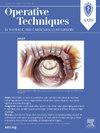经腋动脉经烟囱移植物主动脉内球囊泵置入技术
Q3 Medicine
Operative Techniques in Thoracic and Cardiovascular Surgery
Pub Date : 2025-06-01
DOI:10.1053/j.optechstcvs.2024.10.002
引用次数: 0
摘要
主动脉内球囊泵(IABP)是目前应用最广泛的临时机械循环支持(TMCS)装置,它能增加冠状动脉血流量,减少心脏后负荷。它已被用于各种情况,从改善急性冠状动脉综合征和心源性休克的冠状动脉灌注,到支持衰竭的心脏作为心脏移植的桥梁。随着最近美国供体心脏分配政策的变化,有利于使用TMCS设备的心脏移植候选人,IAPB的使用重新出现,并成为心脏移植的桥梁。在此,我们介绍了一种通过吻合于腋窝动脉的涤纶移植物逐步放置IABP的手术技术。在透视引导下,IABP导管通过导丝进入胸降主动脉。腋窝动脉为IABP的植入提供了一个有希望的替代位置,因为腋窝IABP可以保持更长的时间,并且允许更大的患者活动。研究表明腋窝IABP的成功结果,突出了其相对于股骨插入的潜在优势,特别是在等待心脏移植的患者中。然而,这是一个外科手术,需要熟悉腋窝解剖和细致的注意细节,以尽量减少并发症。本文章由计算机程序翻译,如有差异,请以英文原文为准。
Technique of Intra-Aortic Balloon Pump Insertion Through Axillary Artery Over a Chimney Graft
Intra-aortic balloon pump (IABP), which augments coronary blood flow and reduces cardiac afterload, is the most widely used temporary mechanical circulatory support (TMCS) device. It has been used in a various conditions ranging from improving coronary perfusion in acute coronary syndrome and cardiogenic shock, to supporting a failing heart as a bridge to heart transplantation. With recent changes in donor heart allocation policy that favors heart transplant candidates who are on TMCS devices in the United States of America, there is a resurgence in the use of IAPB and a bridge to heart transplant. Herein we present a step-by-step surgical technique of IABP placement through Dacron graft anastomosed to the axillary artery. Under fluoroscopic guidance, the IABP catheter is advanced over the guidewire into the descending thoracic aorta. The axillary artery offers a promising alternative site to the commonly used femoral artery for the insertion of IABP as axillary IABP can be kept in longer and allows greater patient mobility. Studies indicate successful outcomes with axillary IABP, highlighting its potential advantages over femoral insertion, especially in patients awaiting heart transplantation. However, it is a surgical procedure that requires familiarity with axillary anatomy and meticulous attention to details to minimize complications.
求助全文
通过发布文献求助,成功后即可免费获取论文全文。
去求助
来源期刊

Operative Techniques in Thoracic and Cardiovascular Surgery
Medicine-Surgery
CiteScore
1.40
自引率
0.00%
发文量
59
期刊介绍:
Operative Techniques in Thoracic and Cardiovascular Surgery provides richly illustrated articles on techniques in thoracic and cardiovascular surgery written by renowned surgeons. Each issue presents cardiothoracic topics in adult cardiac, congenital, and general thoracic surgery. Each specialty of interest to the thoracic and cardiovascular surgeon is explored through two different approaches to a specific surgical challenge. Each article is thoroughly illustrated with original line drawings, actual intraoperative photos, and supporting tables and graphs.
 求助内容:
求助内容: 应助结果提醒方式:
应助结果提醒方式:


